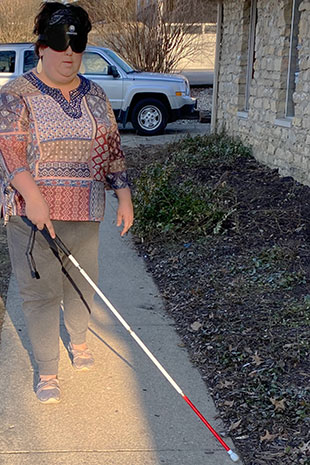March 12, 2021
Shawnee State University is pleased to introduce one of its newest programs, Orientation and Mobility (O&M) - a new field with historical, military beginnings intertwined with the history of teaching students with visual impairments. In numerous cultures as recently as the mid-20th century, individuals with blindness in both the private and public sectors were traditionally hidden away or taught to hide any remnant of their condition.
“The entire field of O&M is still quite young,” said Rebecca Jefferson, current student in SSU’s O&M Program. “It used to be mostly for veterans, but now has opened up for anyone affected by blindness or visual impairments.”
The perception of blindness as weakness, inability, and even second-class citizenship prevailed nationally as well as internationally. Slowly, those misconceptions began to be challenged and formal education has been established to provide and foster independence for individuals with blindness.
O&Ms can also work with babies or people who use wheelchairs and other ambulatory devices. People with more than one disability, such as a visual impairment and hearing impairment, might also be the client of an O&M.
“Blind rehabilitation today involves several areas including assistive technology, sensory efficiency, and social living,” Jefferson said. “The approach emphasizes lesson sequence, comfort level, and skill mastery.”
Students in SSU’s O&M program are learning how to teach those affected by blindness to know where they are and how to get where they need or want to be safely and independently. These clients are taught how to order from restaurants and how to request assistance.
“The O&M program is for those who are willing to invest their time in others,” she said. “The workload is both online and in-person.”
Students of the program also undergo sensory-depriving exercises such as the Monocular Activities. During these activities, students simulate being visually impaired by wearing opaque lenses and they must use a monocular while doing their daily tasks. These tasks include reading a medicine bottle label, television subtitles, a grocery list on a phone app, and outdoor street signs.
“It was certainly a reality check for patience and empathy,” Jefferson said. “Learning new skills can be more difficult than I may sometimes realize, especially with sensory deprivation.”
In order to be eligible for SSU’s O&M program, you must have a bachelor’s degree and a passion for working with people who have visual impairments. The program is 4 semesters long and includes an internship. Students must complete 23 credit hours of graduate-level coursework, 350 hours of an internship, and pass the national certification exam from the Academy for Certification of Vision, Rehabilitation and Education, Professionals (ACVREP). Scholarship support is provided to those who have been admitted and who are wanting to find work in Ohio’s public schools.
Dr. Jennifer Perry, Certified Orientation and Mobility Specialist, leads the program and teaches majority of the coursework.
Once certified nationally by ACVREP, students then become licensed locally in Ohio by registering for the Pupil Services License in Orientation and Mobility. The Pupil Services License is required for working in Ohio Public Schools.
For more information about SSU's O&M program, contact Dr. Jennifer Perry at jperry@shawnee.edu.

